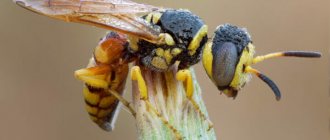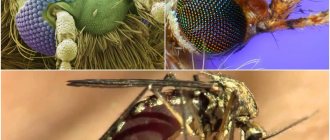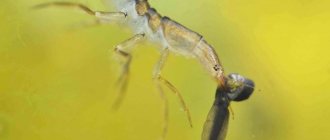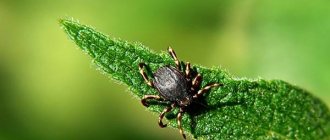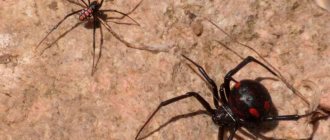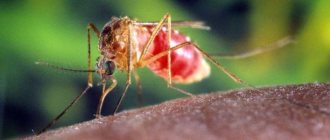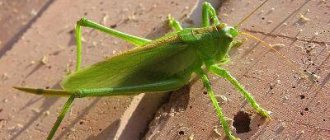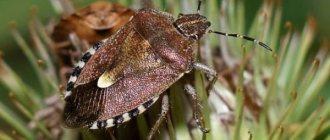Origin of the name praying mantis
The academic name for the praying mantis was given back in 1758 by the great Swedish naturalist Karl Liney, who drew attention to the fact that the pose of a praying mantis in ambush and guarding its prey is very similar to the pose of a man folding his hands in prayer to God. Because of such striking similarity, the scientist gave the insect the Latin name “Mantis religiosa”, which literally translates as “religious priest”; the name “mantis” itself came into our language.
Although it is not called this way everywhere, our hero also has other, not so blissful names, for example, in Spain he is called Caballito del Diablo - the devil's horse or simply - muerte - death. Such creepy names are obviously associated with the equally creepy habits of praying mantises.
Description of the species
The common praying mantis (Mantisreligiosa) belongs to the order Praying Mantis, which includes 2,800 species. The insect's body is narrow and elongated. Males grow up to 43-52 mm, females are much larger - 50-75 mm. An anatomical feature of mantises is the structure of the forelimbs. Grasping legs with spiny elongated femurs and tibiae are designed for holding prey. The thigh and lower leg in a ligament function on the principle of scissors. On the inside of the coxae of the forelimbs there is a dark spot with a white mark in the middle.
Interesting fact. Despite the fact that females are larger than males, males have longer antennae and larger eyes.
The head is triangular, mobile, the insect is able to look back. On the sides there are large, convex compound eyes. In European mantises they have a black pupil. On the forehead there are long thread-like antennae and three simple ocelli. The mouthparts of the gnawing type are directed downwards. The common mantis has two pairs of well-developed wings. Light males and young females are capable of flying over considerable distances.
The forewings are narrow and leathery, they replace the elytra. The hind wings are wide, and when at rest they are folded on the back like a fan. The pronotum expands in the upper part, but never covers the head. The abdomen is elongated, soft, consists of 10 segments. On the last segment there are appendages - cerci. There are 10 pairs of spiracles on the sides of the body.
The color type of the common mantis is protective. Body color can be green (in 80% of cases), yellow, light or dark brown. Camouflage coloring allows you to blend in with the environment. When the insect is motionless, it completely mimics foliage or a twig. Camouflage serves two functions: it allows you to hunt from ambush and hide from enemies.
Information. When attacked by an enemy, the mantis opens its wings to increase in size. It sways from side to side and raises its front legs and the edge of its abdomen threateningly. All actions are aimed at scaring away the aggressor. If the enemy is too large, the mantis flies away.
What a praying mantis looks like: structure and characteristics
The structure of the praying mantis is characterized by an elongated body, which distinguishes it from other arthropod insects.
The praying mantis is perhaps the only living creature that can easily turn its triangular-shaped head a full 360 degrees. Thanks to such a useful skill, he can see an enemy approaching from behind. He also has only one ear, but despite this, he has excellent hearing.
The eyes of the praying mantis have a complex faceted structure, located on the sides of the head, but in addition to them, our hero has three more simple eyes above the base of the antennae.
The antennae of mantises are comb-like, feathery or filamentous, depending on the species of the insect.
Mantises, almost all of their species, have well-developed wings, but mainly only males can fly; females, due to their greater weight and size, find it more difficult to fly than males. The wings of praying mantises consist of two pairs: front and rear, the front ones serve as a kind of elytra that protect the hind wings. Also, praying mantis wings usually have bright colors, and sometimes they even have peculiar patterns. But among the many varieties of mantises, there is a kind of earthen mantis (Latin name Geomantis larvoides), which has no wings at all.
Earth mantis.
Mantises have well-developed forelimbs, which have a rather complex structure - each of them consists of many parts: trochanters, femurs, tibiae and tarsi. The bottom of the thigh has large sharp spines arranged in three rows. There are also spines (though smaller ones) on the mantis’s shin, which is decorated with a sharp, needle-like hook at the end. See the picture for an indicative structure of a praying mantis’ foot.
Mantises hold their prey just between the thigh and the lower leg until their meal is over.
The blood circulation of mantises is primitive, but there is a reason for this - an unusual respiratory system.
The oxygen mantis is equipped with a complex system of tracheae connected to dichals (stigmas) on the abdomen in the middle and posterior part of the body. The trachea contains air sacs that enhance ventilation throughout the respiratory system.
Features and habitat
From the description of the insect, the mantis can be seen that it is quite large, and the length of its body can reach ten or more centimeters.
The typical color characteristic of these insects is white-yellow or green. However, it varies greatly depending on habitat and time of year.
Thanks to the natural ability of mimicry, the color of the insect can exactly repeat the color of stones, branches, trees and grass, so if the praying mantis is in a motionless state, it is very difficult to recognize it with the naked eye among the stormy landscape.
The praying mantis masterfully camouflages itself into the natural landscape
The triangular head is highly mobile (rotates 180 degrees) and connects directly to the chest. Usually you can see a small dark spot on the paws.
The insect has incredibly developed front legs, which have quite powerful sharp spines, with the help of which it can actually grab its prey for further consumption.
The praying mantis has four wings, two of which are dense and narrow, and the other two are thin and wide and can open like a fan.
In the photo, the praying mantis spread its wings
The habitat of the praying mantis is a vast territory, including the countries of Southern Europe, Western and Central Asia, Australia, Belarus, Tatarstan, as well as numerous steppe regions of Russia.
In the United States, this insect came on ships and merchant ships, where it inhabited the decks like cockroaches and mice.
Since the characteristic of the praying mantis is increased heat-loving behavior, it can easily be found in the tropics and subtropics, where it inhabits not only rainforests, but also rocky areas such as deserts.
Sizes of praying mantises
We have already mentioned above that female praying mantises are much larger than males, oddly enough, this is where their main sexual difference manifests itself.
A species of praying mantis, called Ischnomantis gigas in Latin and living in Africa, can reach 17 cm in length; perhaps this representative of the praying mantis kingdom is a real record holder in size.
Ischnomantis gigas is the largest praying mantis in the world.
It is slightly inferior to Heterochaeta orientalis or Heterochaeta eastern, it reaches 16 cm in length. Ordinary mantises are much smaller in size, on average no more than 0.5-1.5 cm in length.
Chinese mantis
From the name you can understand that the birthplace and place of distribution is China. This is a large insect, reaching a length of fifteen centimeters. The male Chinese mantis is much smaller. They are painted green or brown. The peculiarity of this species is its nocturnal lifestyle, although its relatives sleep at night.
In addition, young individuals of this species do not have wings: they grow only after several molts.
What does a praying mantis eat?
It is no secret that our hero is a notorious predator who loves to feed on both smaller insects and is not afraid to attack larger prey even than himself. Flies eat them,
mosquitoes, bees, wasps, bumblebees, butterflies, beetles, etc. Large representatives of the praying mantis family (see above) can even attack small rodents, birds and small amphibians: frogs, lizards.
Mantises usually attack from an ambush, unexpectedly grab the prey with their front paws and do not let go until they have completely eaten it. Strong jaws allow these gluttons to eat even relatively large prey.
Lifestyle
The praying mantis lives and hunts like a typical ambush hunter. The predator freezes until the prey is within reach. It grabs prey with its front legs and starts eating from the head. Males are careful in choosing hunting objects; they attack flies, locusts and other small insects. Large females often attack victims almost equal in size to them. Aggressive individuals attack lizards, birds, and frogs. They jump on the reptile's back and bite its head. The fight continues for several minutes, in the process the hunter can become the victim. If the outcome is successful, the prey is eaten within 2-3 hours. The female remains well fed for up to 4-5 days.
You can meet Mantisreligiosa in the forest, steppe herbs, and meadows. Insects do not even avoid large cities, where they have adapted to live in grass, parks and gardens. The favorite habitats of the common mantis are tall trees and bushes. Insects prefer a sedentary lifestyle. They do not leave their usual territory, they move between tiers. For movement, four limbs are used, less often wings.
Given enough food, they spend their entire lives on one plant. Insects have excellent vision; they detect the slightest movement in the environment. Camouflage coloring allows you to get closer to your prey unnoticed. Hunting takes place during the daytime. All soft tissues of the prey are eaten, leaving chitinous legs and wings. How long a common mantis lives depends on the amount of food and gender. The age of females is longer; on average, representatives of the species live 2-3 months in natural conditions. In captivity, the life expectancy of insects increases several times and is 12-13 months.
Like any insect, the praying mantis has many natural enemies. It is hunted by birds, snakes, small mammals, and bats. The arthropod runs slowly and takes off heavily. Its terrifying dance with its wings spread like a fan scares off only inexperienced young birds. For other large hunters, the mantis is easy prey.
Enemies of Mantises
Although praying mantises are excellent predator hunters, they themselves can also become prey for snakes, some birds or bats. But the main enemies of mantises, perhaps, are their own relatives - other mantises. Fights to the death between two rival mantises are not uncommon. The fights themselves, both between praying mantises and with other insects, are very spectacular; first of all, the praying mantis seeks to scare its opponent, for this it takes a special frightening pose - it throws its front paws forward and lifts its belly up. All this may be accompanied by corresponding threatening sounds. Such a demonstration of strength is by no means feigned; mantises are desperately brave and bravely rush even at a much larger opponent. Thanks to such courage and bravery, mantises often emerge victorious from such fights.
Orchid mantis
It seems to us that this is the most spectacular praying mantis. It got its name for a reason - for its amazing external resemblance to beautiful flowers and orchids. It is on them that the insect ambushes in anticipation of the victim. The females of this species are twice the size of the males: eight and four centimeters. Orchid mantises, even among their fellows, are distinguished by amazing courage: they even attack insects that are more than twice their size.
Where does the praying mantis live?
Almost everywhere, since their habitat is very wide: Central and Southern Europe, Asia, North and South America, Africa, Australia. They are only absent in the northern regions, since mantises are not very accustomed to the cold. But they are perfectly suited, for example, to the hot and humid climate of tropical Africa and South America. Praying mantises thrive in tropical forests, steppe regions, and rocky deserts.
They rarely move from place to place, preferring their usual habitat to unknown distant places, the only reason that can prompt them to travel is the lack of food supply.
Mantis coloring
The color of these insects depends on the conditions in which they live. Thus, mantises living among greenery are green in color, while those living on the ground are brown.
Thanks to their camouflage color, they can sit in ambush for a long time, waiting for their prey and attacking unnoticed. They rarely leave their habitats, only in cases of lack of food.
Types of mantises: photos and names
Scientists have counted about 2000 different species of mantises; unfortunately, we will not be able to list them all in our article, but we will describe, in our opinion, the most interesting representatives.
Common praying mantis
The common praying mantis lives in most countries of Europe, Asia, and Africa. The common praying mantis is a very large representative of the praying mantis kingdom, reaching up to 7 cm (female) and 6 cm (male). As a rule, they are green or brown in color, the wings are well developed, at least, flying from branch to branch is not a problem for the common mantis. The abdomen is ovoid. This type of mantis can be distinguished by a black spot, which is located on the coxae of the front pair of legs on the inside.
Chinese mantis
Obviously, the homeland and main habitat of this type of mantis is China. The Chinese mantis is quite large, females reach up to 15 cm in length, but the size of males is much more modest. They have green and brown colors. A characteristic feature of Chinese mantises is their nocturnal lifestyle, while their other relatives still sleep at night. Also, young individuals of Chinese mantises do not have wings, which grow only after several molts, and then they acquire the ability to fly.
Praying mantis Creobroter meleagris
The praying mantis Creobroter meleagris lives in southwest Asia: India, Vietnam, Cambodia and several other countries. Usually reach 5 cm in length. The colors are white and cream. You can recognize them by the light brown stripes that run along the entire body and head. Also on the wings they have one small and one large spot of white or cream color.
Indian flower mantis
The mantis Creobroter gemmatus especially loves the humid forests of southern India, Vietnam and other Asian countries. This species is small, females grow to only 40 mm, males up to 38 mm. The body is more elongated than that of other relatives. And for additional protection, the Indian praying mantis has special spikes of different heights on its hips. Painted in cream colors. Representatives of this species are excellent flyers, both males and females, due to their low weight, and both pairs of wings are well developed. Interestingly, on the front wings they have a spot similar to an eye with two pupils, which scares away predators. Flower mantises live, as their names suggest, in plant flowers, where they guard their prey.
Spiny flower mantis
The same mantis Pseudocreobotra wahlbergii lives in the countries of southern and eastern Africa. In terms of lifestyle and size, it is very similar to the Indian flower mantis. But what is especially interesting is its coloring - it is truly artistic; on the upper pair of wings there is an interesting pattern reminiscent of a spiral or even an eye. The abdomen of this species has additional spines, which give it its name.
Orchid mantis
The orchid mantis is, in our opinion, the most beautiful representative of the mantis world. It also received its name for a reason, namely for its external resemblance to beautiful orchids, on which it actually hides in ambush, waiting for its next victim. Female orchid mantises are exactly twice as large as males: 80 mm versus 40. And orchid mantises, even among other mantises, are distinguished by amazing courage; representatives of this species are not afraid to attack even insects twice their size.
Heterochaete eastern
The oriental heterochaete, or spiny-eyed mantis, is one of the largest mantises in the world (the female reaches 15 cm in length) and lives throughout most of Africa. These mantises live in the branches of bushes; fortunately, their appearance also resembles twigs.
Character and lifestyle
All species of mantises prefer to live during the day. They have many enemies in nature, from which they prefer not to flee or hide. They simply turn towards the enemy, spread their wings and begin to scream loudly. The sounds are truly threatening; even people are afraid of them.
Why do females eat their partners? The answer to this question has long been found. The fact is that during mating, the female may simply get carried away by the process or confuse the male with some of her prey.
The period of gestation of eggs is typical for females in that they have a great appetite. Their bodies are desperately short of protein, which females take from the most unusual sources, sometimes eating their own kind.
Mating of insects begins with the simple dance of the male. In the process, he secretes an odorous substance, which helps convey to the female that he is from her kind.
Mostly this helps, but since mantises are cannibals, it doesn't always work. The female bites off her gentleman's head, and then simply cannot stop, devouring him all with great pleasure.
These predators have amazing agility. After sitting in ambush for a long time, they can make a sharp leap towards their prey and in a matter of seconds dig into it with their claws. When jumping, they are excellent at controlling their body, which is another distinctive feature of mantises .
Reproduction of praying mantises
And here we move on to the most interesting part, namely the reproduction of mantises, which, as a rule, has a sad and tragic end for the males. But let's not get ahead of ourselves, but start in order. With the onset of the mating season (usually in the fall), male praying mantises, using their olfactory organs, begin searching for females ready to mate. Having found one, he performs a special “mating dance” in front of her, which elevates him to the rank of sexual partner. Then the mating process itself begins, during which the female praying mantis has the bad habit of biting off her male’s head and then completely eating him. Some scientists believe that this behavior, which is more than creepy in our opinion, also has its own biological reasons - having eaten her “groom”, the female in this simple way replenishes the reserves of nutritious protein substances necessary for future offspring.
Mantis mating
Although it also happens that the male manages to get away from his “beloved” in time, thereby avoiding the sad fate of food.
After some time, the fertilized female lays eggs, simultaneously enveloping them with a special sticky secretion, which is secreted by their special glands. This secretion serves as a kind of protective capsule for the eggs of future mantises and is called an ooteca. The fertility of a female depends on its species; usually a female is capable of laying from 10 to 400 eggs at a time.
Praying mantis larvae stay in the eggs from three weeks to six months, after which they crawl out of the eggs. Further, their development proceeds at a fairly fast pace and after about 4-8 molts the larva degenerates into an adult mantis.
Social structure and reproduction
Photo: Male praying mantis
Mantises live from two months to one year; in rare cases, some individuals exceed the mark of one and a half years, but only in artificially created conditions. Young animals are capable of reproduction within a couple of weeks after birth. During their lives, females participate in mating games twice; males often do not survive the first breeding season, which in mid-latitudes usually begins in August and ends in September, and in warmer climates can last almost the entire year.
The male attracts the female with his dance and the secretion of a specific sticky secretion, by the smell of which she recognizes it as her kind and does not attack. The mating process can last from 6 to 8 hours, as a result of which not every future father is lucky - more than half of them are eaten by a hungry partner. The female lays eggs from 100 to 300 at a time on the edges of leaves or on the bark of trees. During laying, it secretes a special liquid, which then hardens, forming a cocoon or ootheca to protect the offspring from external factors.
The egg stage can last from several weeks to six months, depending on the air temperature, after which larvae crawl out into the world, which in appearance are radically different from their parents. The first moult occurs immediately after hatching and there will be at least four of them before they look like their adult relatives. The larvae develop very quickly, and after hatching they begin to feed on small flies and mosquitoes.
Keeping praying mantises at home
Terrarium
It would be a very exotic and unusual act to get yourself a pet praying mantis, wouldn’t it? However, there are people who have such “pets” and if you also want to join them, then the first thing you will have to take care of is the terrarium. A relatively small glass or plastic terrarium with a mesh lid is suitable; its dimensions should be at least three times the size of the mantis itself. Inside it would be nice to place twigs or small plants on which the praying mantis will climb like trees.
Temperature
Praying mantises are heat-loving insects, so the optimal temperature for them will be from +23 to +30 C. You can use special heaters for terrariums.
Humidity
Also, do not forget about humidity, which is also important for these insects. The optimal humidity for praying mantises is 40-60%, and to maintain it, you can place a small container of water inside the terrarium.
What to feed praying mantises at home
Live food. Perfect fit
crickets, grasshoppers, cockroaches, flies. Some species of praying mantises will not mind eating ants. And at the same time, they need to be fed regularly, so keeping such “pets” can be somewhat troublesome. But you don’t need to give praying mantises water, since they get the liquid the body needs from food.
How do praying mantises hunt?
These ferocious insects don't just hunt like robots, according to a study published in the journal Biology Letters. It's much, much scarier - the mantises calibrate their attacks to more effectively capture prey as it flies past - and at different speeds.
According to the New York Times, predatory animals are traditionally divided into two categories depending on how they catch prey. The first group chases predators and knocks them down (this is how cheetahs and other large predators usually hunt). The second group is better known as wait-and-see predators - they hide and wait for the right moment, and then immediately strike.
However, recently this view has been called into question. By studying mantis shrimp, which capture prey with super-fast strikes, scientists have discovered that these insects control the speed of the strike! And the results of a 2016 study of praying mantises showed that they are flexible when “catching” stationary insects. Look at this photo:
This is a screenshot of a video of a praying mantis carefully watching a fly fly by. Before she even had time to blink an eye, she was already grabbed - quickly, and most importantly, without a doubt, all the movements of the mantis were clearly calculated
In the experiment, the researchers placed one Madagascan marbled mantis at a time on an elevated platform under a bright light. Then they directed the prey - either a dead beetle or a similar bead - towards the mantis on a transparent wire. The target could move at three speeds, each of which had to approach a different type of mantis prey. The slowest of them, 200 millimeters per second, is the average flight speed of a fruit fly. The fastest - 730 millimeters per second - simulated a falling fly. The authors of the work placed eight different praying mantises through dozens of swings, filming each of them with a high-speed camera. They then analyzed the recorded movements of the insects.
Rhombodera basalis, Malaysian shield mantis
So, it turns out that mantises do indeed adjust their strike speed depending on how fast their prey is moving. As the researchers write in their paper, given that some impacts last less than one tenth of a second, this is highly unusual. Moreover, the results of the study again raise the question of what insects are capable of and whether we know them as well as we think.
Interesting facts about praying mantises
Benefits and harms for humans
The insect behaves quite aggressively, so many people have a fear of it. Moreover, many representatives are large in size.
The question arises, why is the praying mantis dangerous for humans? The praying mantis does not pose a serious threat to humans, but can easily injure with its claws. To avoid trouble, you should not let small children near it, because the habits of the insect are far from angelic.
By eating many pests, the predator benefits agriculture, but at the same time it also destroys beneficial insects, such as bees.
The praying mantis is a typical predator
The praying mantis is a typical example of a predator in wait, or, in other words, an “ambush”. For hours he can sit quietly in a secluded place, waiting for prey. The camouflage coloring allows the mantis to blend in with the vegetation, and even the shape of its body resembles part of a plant. Although it lives among an abundance of greenery, it does not accept plant foods. Moreover, the carnivorous insect eats its prey exclusively alive.
Praying mantises are merciless not only towards other insects smaller in size, which for them are nothing more than a tasty lunch, but also towards their relatives. Anyone who keeps this aggressive creature as a pet needs to know this. Two or more praying mantises are unlikely to live together, especially if one is larger than the other.
In the Middle Ages in Japan, the praying mantis was considered a symbol of courage and cruelty, and even the image of the insect was applied to the hilts of samurai swords. And one of the positions in kung fu repeats the pose of a praying mantis, ready for battle. In addition, in China they believed that the praying mantis had healing powers and could cure some diseases. The ancient Greeks considered the praying mantis a harbinger of spring and a weather predictor; they called it a “prophet” and “soothsayer.” And in some European countries, even today, praying mantises are credited with some kind of magical power. Perhaps this creature, which is an object of superstition, will arouse your interest and you will want to keep it as a treasure?
Offspring of praying mantises
The common mantis lays eggs in swellings. This form of masonry is characteristic of smallmouths and cockroaches. The clutch is a horizontal row of eggs. The female fills the eggs with foamy liquid. When the liquid hardens, it forms a protective capsule. One clutch usually contains up to 300 eggs. The capsule is quite hard and can easily stick to the stems of the plant.
Good humidity and temperature are maintained inside the shell. Eggs in such conditions can survive even frosts, down to minus 18 degrees. The incubation period in warm areas where common mantises live is 30 days to develop into larvae. In cold areas of residence, eggs are left for the winter.
https://www.youtube.com/watch?v=cLIXKJz6Iwg
Larvae are formed after 30 days of incubation period. There are small spines on the surface of the larvae that help them get out from under the shell. Once the larva is released, it molts over time. Becomes similar to an adult after shedding its skin. Puberty of the common mantis occurs after two weeks.
Spiny flower mantis
Pseudocreobotra wahlbergii is a native of Africa. It closely resembles the Indian flower mantis. Its color is especially interesting: on the upper pair of wings you can see a pattern that resembles a spiral. Representatives of this species have spines on their abdomen, which give the species its name. Representatives of this species are painted in cream shades.
They fly beautifully, both males and females, due to their light weight, and the wings of such insects are well developed. Interestingly, these insects have spots on them that resemble an eye with two pupils, which, according to researchers, can scare away predators. Representatives of the species live in plant flowers, where they lie in wait for their prey.
Coloring
You are probably familiar with the common praying mantis from your school biology textbooks. Its color type is very variable, ranging from yellow or green to dark brown or brownish-gray. Usually it corresponds to the habitat and matches the color of the grass, stones and leaves.
The most common color is green or white-yellow. Older individuals have a paler outfit. Dark brown spots appear on the body with age. This is explained by the fact that the body stops producing amino acids important for life: methionine, leucine, tryptophan, etc. In laboratory conditions, when these substances are added to food, the life of the insect almost doubles - up to four months. This is the maximum period that an ordinary praying mantis can live.
The lifestyle of praying mantises and their diet
Praying mantises are predators; their main food is their classmates, i.e. - other insects. The largest individuals can attack, and even birds. The predator eats its prey slowly, the feeding process lasts about 3 hours, and the food is digested over the course of a week.
Mantises hunt small insects from ambush. Thanks to the protective coloring, the predator is very difficult to notice. He simply waits for some insect to crawl past him and then grabs it. And praying mantises chase large victims; when they catch up, they jump on their backs, grab them by the head, and begin to slowly eat them.
The praying mantis, despite its “pious” name, is a real predator.
Mantises only react to moving targets and are not interested in stationary objects. This predator is incredibly voracious. An adult mantis eats up to 7 cockroaches measuring 1 centimeter at a time. It takes 30 minutes to eat each victim. First, the insect eats soft tissues, and then proceeds to hard ones. The mantis leaves only bits of limbs and wings from the cockroach. The praying mantis can eat softer insects whole.
As a rule, the insect chooses a sedentary lifestyle; if there is enough food, the mantis can live on one tree throughout its life. Praying mantises are most often located on the branches of trees and bushes, but they can also freeze in the grass or directly on the ground.
Praying mantises are very prolific creatures.
Why does a female praying mantis eat the male after mating?
Cannibalism among praying mantises is, in principle, natural, but it happens extremely rarely. Eating a partner is not necessary for mating. Since the female is larger and can be very hungry, after the process any food will do for her, but often this does not happen, and the male simply leaves, albeit quickly and quietly, but he leaves.
Who is the praying mantis
The praying mantis is a large predatory insect.
The scientific name of the insect is the common mantis. The famous animal researcher Carl Linnaeus mentions it as Mantis religiosa. From Greek, the first part is translated as “prophet”, and the second, from Latin – “religious”.
The insect is quite large, up to 5–7 cm, with an elongated, narrow body and long limbs. The wings are large and well developed, but more often they simply run on the ground than fly.
The abdomen is shaped like an egg. Body color varies. The main color is green, but it can also have a yellow tint, gray or brown. Thanks to this, it can be difficult to notice among the grass or branches.
The praying mantis is the closest relative of cockroaches, but unlike them, it is a predatory insect. It grabs prey with its front paws and eats it. When the praying mantis sits motionless, it raises and folds these legs as if praying. This is where all his nicknames came from.
Where do praying mantises live?
Today these insects are found in southern Europe, Asia, Africa, America, Australia and are very numerous throughout their range. Praying mantises adapt well to different biotopes and, with an abundant food supply, prefer a sedentary lifestyle.
Despite their frightening appearance, mantises are highly valued by farmers of all countries, they welcome them and try to use them as an effective biological weapon to combat insects - agricultural pests.
In America and a number of Asian countries, they are kept as pets - exterminators of flies and mosquitoes, and lovers of exotic insects decorate their insectariums with them.
Common praying mantis (Mantis religiosa).
Common mantis, or religious mantis.
Common praying mantis.
Common praying mantis in the grass.
Mantis, macro photography.
A praying mantis on top of a cliff, against the backdrop of the Black Sea coast.
